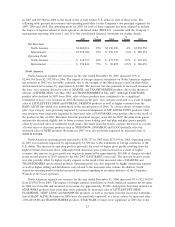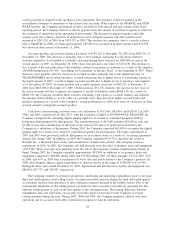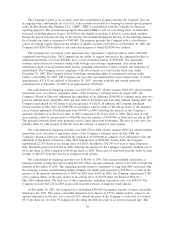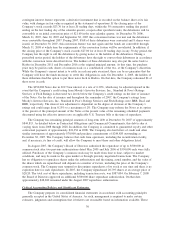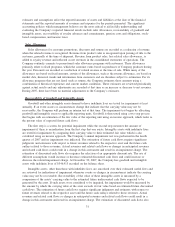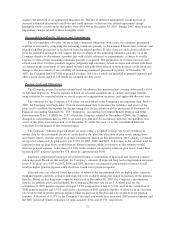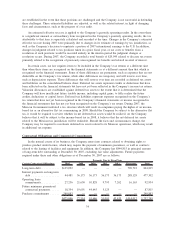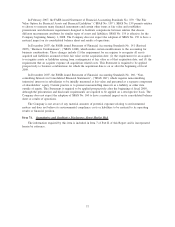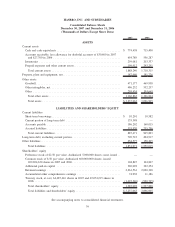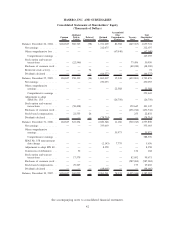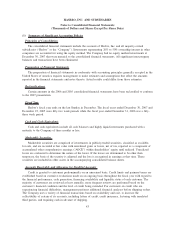Hasbro 2007 Annual Report Download - page 41
Download and view the complete annual report
Please find page 41 of the 2007 Hasbro annual report below. You can navigate through the pages in the report by either clicking on the pages listed below, or by using the keyword search tool below to find specific information within the annual report.
In accordance with Statement of Financial Accounting Standards No. 87, “Employers Accounting for
Pensions”, actual results that differ from the actuarial assumptions are accumulated and, if outside a certain
corridor, amortized over future periods and, therefore generally affect recognized expense in future periods. At
December 30, 2007, the Company’s U.S. plans had unrecognized actuarial losses of $19,158 included in
accumulated other comprehensive income related to its defined benefit pension plans. Pension plan assets are
valued on the basis of their fair market value on the measurement date. Changes in the fair market value of
plan assets may impact the amount of future pension expense. During 2007 there were not significant declines
in the fair value of pension plan assets. As of December 30, 2007, the Company froze benefits under its
largest pension plans in the U.S., with no future benefits accruing to employees. The Company will continue
to pay benefits under the plan consistent with the provisions existing at the date of the plan benefit freeze.
Stock-Based Compensation
The Company has a stock-based compensation plan for employees and non-employee members of the
Company’s Board of Directors. Under this plan, the Company may grant stock options at or above the fair
market value of the Company’s stock, as well as restricted stock, restricted stock units and contingent stock
performance awards. On December 26, 2005, the first day of fiscal 2006, the Company adopted SFAS 123R,
which requires the Company to measure all stock-based compensation awards using a fair value method and
record such expense in its consolidated financial statements.
The Company uses the Black-Scholes option pricing model to value stock options that are granted under
these plans. The Black-Scholes method includes four significant assumptions: (1) expected term of the options,
(2) risk-free interest rate, (3) expected dividend yield, and (4) expected stock price volatility. For the
Company’s 2007 and 2006 stock option grants, the weighted average expected term was approximately 5 years.
This amount is based on a review of employees’ exercise history relating to stock options as well as the
contractual term of the option. The weighted average risk-free interest rates used for 2007 and 2006 stock
option grants were 4.79% and 4.98%, respectively. This estimate was based on the interest rate available on
U.S. treasury securities with durations that approximate the expected term of the option. The weighted average
expected dividend yields used for the 2007 and 2006 stock option grants were 1.97% and 2.55%, respectively,
which is based on the Company’s current annual dividend amount divided by the stock price on the date of the
grant. The weighted average expected stock price volatilities used for 2007 and 2006 stock option grants were
22% and 24%, respectively. These amounts were derived using a combination of current and historical implied
price volatility. Implied price volatility represents the volatility implied in publicly traded options on the
Company’s stock, which the Company believes represents the expected future volatility of the Company’s
stock price. The Company believes that since this is a market-based estimate, it provides a better estimate of
expected future volatility as compared to based only on historical volatility.
In 2007 and 2006, as part of its employee stock-based compensation plan, the Company issued contingent
stock performance awards, which provide the recipients with the ability to earn shares of the Company’s
common stock based on the Company’s achievement of stated cumulative diluted earnings per share and
cumulative net revenue targets over the three fiscal years ended December 2009 for the 2007 award, and over
a ten quarter period beginning July 3, 2006 and ending December 2008 for the 2006 award. Each award has a
target number of shares of common stock associated with such award which may be earned by the recipient if
the Company achieves the stated diluted earnings per share and net revenue targets. These awards are valued
based on the fair market value of the Company’s stock on the date of the grant. The measurement of the
expense related to this award is based on the Company’s current estimate of revenues and diluted earnings per
share over the performance period. Changes in these estimates may impact the expense recognized related to
these awards.
Income Taxes
The Company’s annual tax rate is based on its income, statutory tax rates and tax planning opportunities
available in the various jurisdictions in which it operates. Significant judgment and estimates are required to
determine the Company’s annual tax rate and in evaluating its tax positions. Despite the Company’s belief that
its tax return positions are fully supportable, these positions are subject to challenge and estimated liabilities
33


